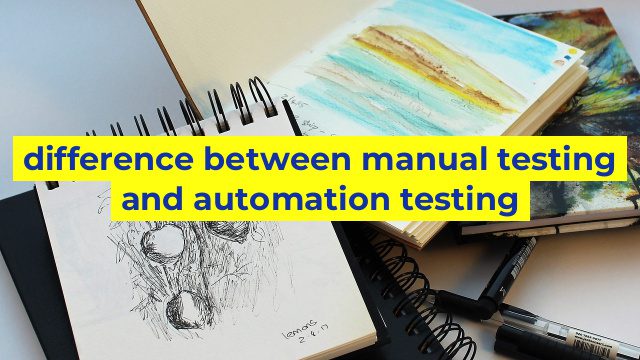The Differences Between Manual Testing and Automation Testing
Introduction
Testing is an essential part of software development life cycle. It helps in delivering quality software products to the end-users. When it comes to testing, there are two ways to approach it – manual testing and automation testing. Both forms of testing have their pros and cons. In this article, we will discuss the differences between manual testing and automation testing.
Manual Testing
In manual testing, a tester manually executes test cases without the help of any tool or script. The aim is to identify defects and ensure the software meets the requirements of the end-users. Manual testing is a time-consuming process and requires a lot of effort from the testers.
Pros:
– Manual testing is more flexible as testers can make changes on the fly, as opposed to automation testing which requires modifying the code.
– Manual testing allows testers to use their intuition and domain knowledge to identify defects that may be missed by automated tests.
– Manual testing is the only way to test usability and user experience.
Cons:
– Manual testing can be slower and more expensive than automation testing as it requires more manpower.
– Manual testing is prone to human error and inconsistencies, which may lead to missed defects.
Automation Testing
In automation testing, testers use software tools and scripts to execute and analyze tests. Automation testing is used to perform repetitive tasks, such as regression testing, performance testing, and load testing.
Pros:
– Automation testing is faster than manual testing and can save a lot of time and effort.
– Automation testing is more reliable and consistent as it eliminates the possibility of human error.
– Automation testing can be less expensive in the long run, as it requires less manpower.
Cons:
– Automation testing requires a lot of initial investment in terms of time and resources to create and maintain the automation suites.
– Automation testing is not suitable for testing the usability and user experience of the software.
– Automation testing can only detect the defects that are programmed into the automation suite.
Conclusion
Both manual testing and automation testing have their pros and cons. As a software development team, it is important to decide which form of testing is best suited for your project. Some projects may require manual testing for its flexibility and usability testing, while others may require automation testing for its speed and reliability. Regardless of the method used, testing is an integral part of software development, ensuring that the software meets the needs and expectations of its users.
Table difference between manual testing and automation testing
| Manual Testing | Automation Testing | |
|---|---|---|
| Definition | Testing done manually without using any tool or script. | Testing done using automation tools or scripts. |
| Accuracy | Manual testing can be prone to human error and can lack consistency in execution. | Automation testing is more accurate and consistent, as it replicates the exact same steps every time the script is run. |
| Cost | Manual testing is often less expensive than automation testing, as it does not require tools or scripts. | Automation testing can be more expensive upfront, as it requires purchasing tools and creating scripts. However, it can save costs in the long run due to increased efficiency. |
| Time | Manual testing can be time-consuming, especially for repetitive or large-scale testing. | Automation testing is faster, as it can execute tests quickly and repeatedly without human intervention. |
| Coverage | Manual testing may not always cover all possible scenarios, especially under time constraints or limited resources. | Automation testing can cover more scenarios and edge cases, as scripts can test a large number of inputs and outputs within a short time. |
| Skill Set | Manual testing requires less technical skills and training, as it involves executing tests manually. | Automation testing requires technical skills such as scripting and programming, as well as training on the automation tools. |

